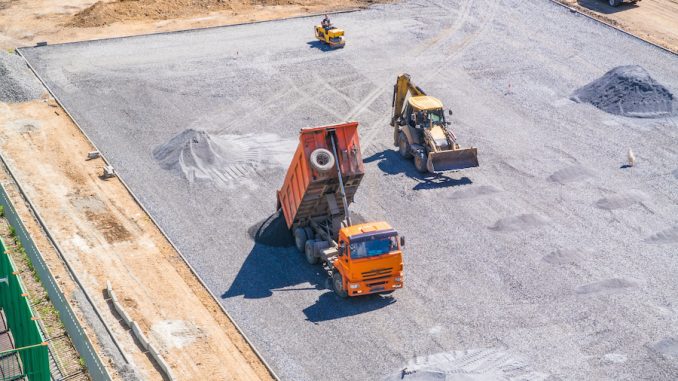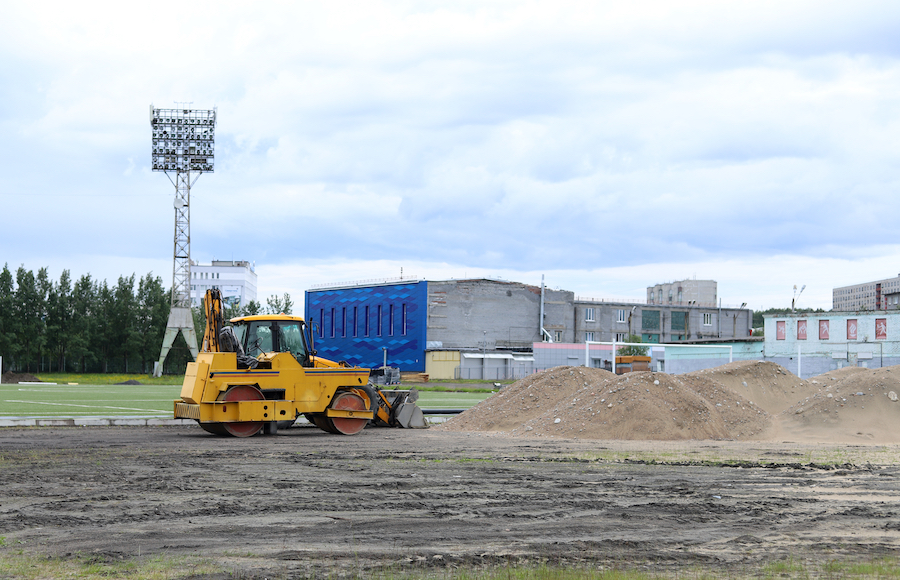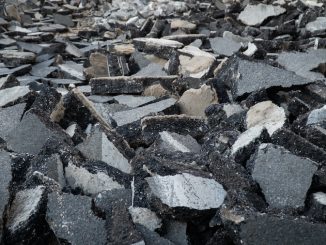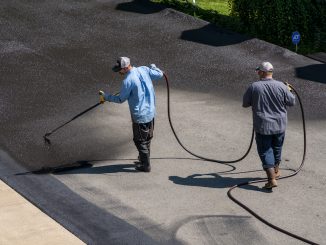
Our Asphalt Design Guide article series, based on the Asphalt Paving Design Guide by Minnesota Asphalt Pavement Association, will give you information about using asphalt in your construction projects. In our third article, we discussed parking lot design. In this final article, we discuss asphalt design for recreational uses.
Asphalt Pavements for Non-Vehicular Use
In addition to highways, streets, and parking lots that carry autos and trucks, many other applications for asphalt pavements exist. Sidewalks, bicycle and golf cart paths, playground areas, tennis courts, and site paving are some common applications.
Because of the unique nature of these asphalt pavement applications, a more detailed approach to their design is presented here. In many cases, the primary design consideration is a pavement structure capable of supporting occasional maintenance and emergency vehicles and resisting freeze/thaw cycles. Therefore, a minimum thickness to accommodate these loads may be the basis of the thickness design.
Bikeways, Golf Cart Paths, Recreational Trails, and Walkways
It is desirable to blend this type of pathway into the contours of the existing ground to preserve aesthetics and to reduce the impact on the natural environment. Surface drainage should flow away from these pathways wherever possible.
Because of the variety of designs and applications, individual pathway widths are not listed here. For bikeway and golf cart paths in particular, the size and availability of conventional road construction and maintenance equipment may determine width. Generally, a minimum width of 8 feet is recommended; however, a 12-foot width may be more cost effective. As a safety measure, additional widening on sharp curves is recommended.
Recreation trails and walkways are usually paved to an 8-foot width to accommodate construction and maintenance operations and to provide access for emergency vehicles. It may be desirable to pave a walkway in an urban environment only 4-feet wide (or wider if significant numbers of pedestrians are present).
Pavements of this type are not designed to withstand repeated loads from heavy maintenance or emergency vehicles; such loadings should be infrequent.

Construction Practices
Drainage
It is particularly important to keep water away from the subgrade soil. If the soil becomes saturated, it will lose strength and stability, making the overlying pavement structure susceptible to breakup under imposed loads. Both surface and subsurface drainage must be considered. All drainage must be carefully designed and should be installed as early in the construction process as practical.
Bicycle and golf cart paths should have a target slope of 2 percent (2’ per 100’). They should be constructed in such a way that water will not collect at the pavement edge. An underdrain system may be required to carry water away from the pavement structure.
Subgrade Preparation
Because the subgrade must serve both as the working platform to support construction equipment and as the foundation for the pavement structure, it is vital to ensure that the subgrade is properly compacted and graded. All underground utilities should be protected or relocated before grading. All drainage structures should be completed with the grading. Remove all topsoil and debris from the areas to be paved. The subgrade should be shaped properly to meet true alignment and elevation. It should be compacted to not less than 95 percent of maximum laboratory density (AASHTO T-99). The surface elevation should not vary more than 3/4 inch from the established grade.
Areas that show a pronounced deflection under heavy construction traffic indicate instability in the subgrade. Such areas probably require removal of the material and replacement with suitable subgrade soil material such as compacted, crushed stone or compacted, bituminous-concrete base. If a water seepage area is encountered, the subgrade should be drained.
Asphalt Pavements
Bicycle, golf cart paths, recreational trails, and sidewalks may be constructed in one course or with a separate base and surface course.
When using the full-depth concept, the asphalt pavement base course should be placed directly on the prepared subgrade in one lift, spread and compacted. Compaction is one of the most important construction operations in terms of its contribution to the performance of the completed pavement.
If a compacted aggregate base is proposed, place it on the prepared subgrade and compact it to ensure a hard, uniform and stable surface.
The surface course, or the full-depth asphalt pavement base course, should be placed to the true line and grade. Any irregularities in the surface of this course should be corrected directly behind the paver. As soon as the material can be compacted without displacement, rolling and compaction should be started and should continue until the surface is thoroughly compacted and roller marks have disappeared.
Tack Coat
A tack or bond coat must be applied at the rate of 0.02 to 0.05 gallons per square yard between each course. The surface must be cleaned of all dust, dirt, or other loose material before the bond coat is applied. If emulsion is used, it should be diluted with equal parts of water or as specified in the proposal.
Pavement Thickness
The pavement thickness for bikeways, golf cart paths, recreational trails, and walkways should be in accordance with the following table.

Construction Practices
Drainage
Both surface and subsurface drainage should be investigated. If excessive moisture is allowed to accumulate under the pavement, the life of the playground surface may be shortened. If necessary, a system of subsurface drainage must be constructed. Surface drainage on the playground should be directed to the pavement edges and carried away in suitable channels or drainage facilities. It is recommended that the minimum pavement cross-slope be 2 percent (2’ per 100’) to preclude standing water and ensure rapid drainage.
Subgrade Preparation
Because the subgrade must serve as both the working platform to support construction equipment and as the foundation for the pavement structure, it is critical that the subgrade be properly graded and compacted. All drainage structures should be installed with the grading.
Remove all topsoil and debris from the areas to be paved. The subgrade should be properly shaped to meet true alignment and elevation. It should be compacted to not less than
95 percent of maximum laboratory density (AASHTO T-99). The surface should not vary more than 3/4 inch from the established grade. Caution should be exercised in the soil selection for the upper portion of the subgrade. A variation in soil type and/or properties can result in differential heave caused by moisture fluctuations and/or frost action that could affect the uniformity of the pavement surface over time.
Areas of the subgrade that are anticipated for asphalt paving may be tested for uniformity and adequacy of support by driving a loaded dump truck at a speed of 2 to 3 mph over the entire surface. Areas that show a deflection of 2 or more inches should be further improved, such as with a compaction subcut or an additional thickness of asphalt pavement. When the improvement is completed, the finished grade should be hard, stable and constructed in reasonably close conformance with the lines, grades and proposed typical cross sections to allow for a working platform for paving construction equipment and associated activities. This process can be used to evaluate the stability of aggregate base; however, the deflection should be minimal.
Base Construction
If the full-depth concept of construction is being used, the asphalt pavement base material should be placed directly on the prepared subgrade. The material must be spread and compacted to the required thickness and density as specified and to the grades and dimensions shown on the plans.
If a compacted aggregate base is proposed, place it on the prepared subgrade and compact it to ensure a hard, uniform, and stable surface. The surface of the completed base should not deviate more than 1/2 inch when measured with a 10-foot straight edge.
Tack Coat
A tack or bond coat must be applied at the rate of 0.02 to 0.05 gallons per square yard between each asphalt pavement course. The surface must be cleaned of all dust, dirt, or other loose material before the bond coat is applied. If emulsion is used, it should be diluted with equal parts of water or as specified in the proposal.
Surface Course Construction
A surface course of asphalt pavement may be placed on the previously constructed asphalt pavement base after the tack coat has been applied. It must be spread and compacted to the required thickness and density as specified and in the grades and dimensions shown on the plans. The finished surface must not deviate more than 1/4 inch when measured with a 10-foot straight edge.
Pavement Thickness
The pavement thickness for playgrounds should be in accordance with the following table.

Tennis Courts
The following information and design guidance cover the basic components of building durable, economical asphalt pavements for tennis courts. For general guidelines covering layout and dimensions, contact the United States Tennis Association www.usta.com or the United States Tennis & Track Builders Association www.ustctba.com.
These pavements usually are not designed to withstand repeated loads from heavy maintenance or emergency vehicles, but an occasional load application can be made without damage.
Construction Practices
Drainage and Surface Slope
Both surface and subsurface drainage must be thoroughly investigated. Proper drainage is vital to ensure a non-cracked, smooth playing surface for many years. If subsurface drainage conditions are not satisfactory, a perimeter drain is recommended. An asphalt pavement base on a suitable type of subgrade soil may not require underdrainage.
In order to drain properly, the finished court surfaces should have a minimum slope of 1 inch per 10 feet on a true plane from side to side, end to end, or corner to corner. The surface should not slope away in two directions from the net.
Subgrade Preparation
All topsoil and debris must be removed from the areas to be paved. The subgrade should be properly shaped to meet true alignment and elevation.
The subgrade must be shaped to meet true lines and elevations and compacted to not less than
95 percent of maximum laboratory density (AASHTO T-99). The surface of the compacted subgrade must not vary more than 3/4 inch from the established grade. Good compaction and subgrade soil selection is particularly important in tennis court construction, because differential settlement or heaving from frost action may cause cracking in the court surface. In some cases this can render the court unusable.
Base Construction
If the full-depth concept of construction is being used, the asphalt pavement base material should be placed directly on the prepared subgrade. The material must be spread and compacted to the required thickness and density as specified and to the grades and dimensions shown on the plans.
If a compacted aggregate base is proposed, it should be placed on the prepared subgrade and compacted to ensure a hard, uniform and stable surface.
The surface of the completed base must not deviate more than 3/8 inch when measured with a 10-foot straight edge but should slope 1 inch per each 10 feet on a true plane from side to side, end to end, or corner to corner as indicated on the plans.
Tack Coat
A tack or bond coat must be applied at the rate of 0.02 to 0.05 gallons per square yard between each course. The surface must be cleaned of all dust, dirt, or other loose material before the bond coat is applied. If emulsion is used, it should be diluted with equal parts of water or as specified in the proposal.
Surface Course Construction
A surface course of asphalt pavement must be placed on the previously constructed asphalt pavement base, spread and compacted to the required thickness and density as specified and to the grades and dimensions shown in the plans.
The finished surface shall not deviate more than 1/8 inch when measured with a 10-foot straight edge but must slope 1 inch per each 10 feet on a true plane from side to side, end to end, or corner to corner as indicated on the plans.
Pavements of this type are not designed to withstand repeated loads from heavy maintenance or emergency vehicles; such loadings should be infrequent.
Caution: Aggregate containing spall and iron-oxides can cause surface pitting and/or staining.
Color Finish Course (If Specified)
Before applying the color finish course, the court should be given a water check to determine if there are any depressions (birdbaths) that allow water to pond. This is done by flooding the surface with water and allowing it to drain. Depressions of sizable dimensions – greater than 1/8 inch in depth – should be patched and leveled with the material recommended by the color finish manufacturer.
The color finish material may be one of several proprietary products and must be applied according to manufacturer’s directions.
Playing Lines
Following construction, it is recommended that a minimum of 15 days elapse before applying the playing lines. A latex striping-paint should be used. It should be placed no thicker than necessary for delineation. Base lines should not be more than 4 inches wide and playing lines should not be more than 2 inches wide. Base and playing lines must be accurately located and marked in accordance with the rules of the United States Lawn Tennis Association.
If a color finish has been applied, the striping paint should be from a manufacturer and of a type recommended by the surface coating manufacturer. It should be painted in accordance with the paint manufacturer’s standard specifications.
Pavement Thickness
The pavement thickness for tennis courts should be in accordance with the following table.

Construction Practices
Subgrade Preparation
Remove all large rocks, debris, and topsoil from the area to be paved. All vegetation, including root systems, should be removed. Install all drainage and utility facilities, and properly backfill and compact the subgrade.
The subgrade must be properly shaped to meet true lines and elevations. It must be compacted to not less than 95 percent of maximum laboratory density (AASHTO T-99). The elevation surface of the compacted subgrade must not vary more than 3/4 inch from the established grade.
Areas of the subgrade that are anticipated for asphalt paving may be tested for uniformity and adequacy of support by driving a loaded dump truck at a speed of 2 to 3 mph over the entire surface. Areas that show a deflection of 2 or more inches should be further improved, such as with an additional thickness of asphalt pavement. When the improvement is completed, the finished grade should be hard, stable, and constructed in reasonably close conformance with the lines, grades and proposed typical cross sections to allow for a working platform for paving construction equipment and associated activities. This process can be used to evaluate the stability of aggregate base, however, the deflection should be minimal.
Base Construction
If the full-depth concept of construction is being used, the asphalt pavement base material should be placed directly on the prepared subgrade. The material must be spread and compacted to the required thickness and density as specified and to the grades and dimensions shown on the plans.
If a compacted aggregate base is proposed, place it on the prepared subgrade and compact it to ensure a hard, uniform, and stable surface.
The surface of the completed base must not deviate more than 1/2 inch when measured with a 10-foot straight edge.
Track Surfacing
For surfacing design and construction specifications, please refer to references such as the United States Tennis Court & Track Builders Association. www.ustctba.com.
Conclusion
The asphalt design for recreational use, in most cases, will be thinner and narrower as compared to roadways and parking lots. This is because humans cause less wear and tear than vehicles. Pavement thickness will need to be adjusted depending on the quality of the subsoil. Whether you are building a playground, tennis court, or walking trail, asphalt is an excellent choice for nearly any recreational use.
What is the recommended minimum width for bikeways and golf cart paths in asphalt paving for recreational use?
A minimum width of 8 feet is recommended for bikeways and golf cart paths, while 12 feet may be more cost-effective.
How should the drainage be managed in asphalt pavement design for recreational trails, walkways, and playgrounds?
Adequate surface and subsurface drainage, with a target slope of 2 percent for bicycle and golf cart paths, is crucial to prevent water accumulation and ensure pavement stability.












































